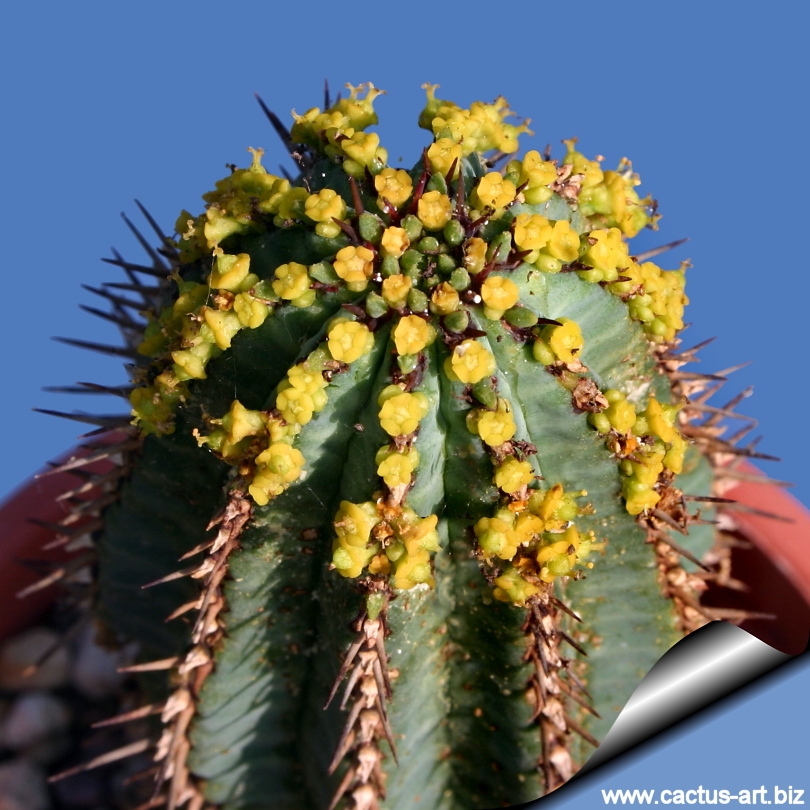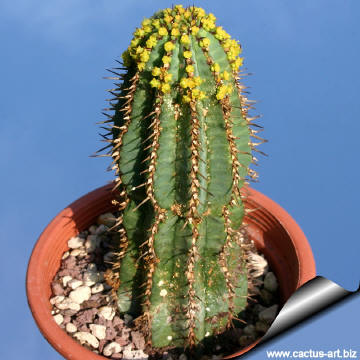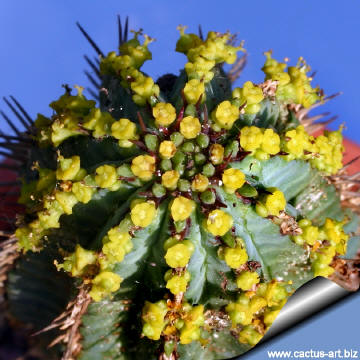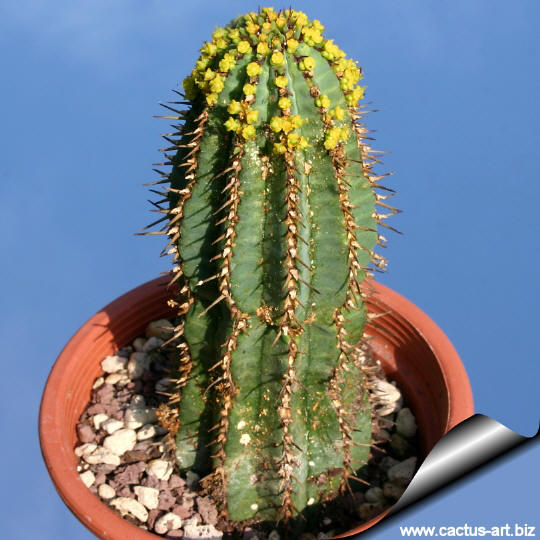|
|
|

Euphorbia fruticosa
This is a very showy species with blue-green multifluted stems,
it is stunning in bloom, when the apexes of the columns are covered with
tiny yellow cyathia along the ridges between the paired spines.
|
|
Description: Succulent to
woody cactus-like shrubs, branching at the base to form a spiny cushion
of many twin-spined stems.
Stems: Columnar, up to 9 cm in diameter and 50-70 cm tall, chunky
powdery blue-green or yellowish-green, ribbed. A 'blue' form is
available.
Ribs: 10 to 13 deep, vertical or slightly twisted with shallow
and very closely set teeth.
Leaves: Small, short lived, obovate, fasciculate
Spines: In pairs from a tan spine shields, and very packed
(almost touching) on the rib border, short, tiny, tan coloured
that spreads at right angle
Flowers: Monoecious and showy bright yellow cyathias on 2-3
forked cymes, clustered in 2 to 5 rayed umbels. They grow numerous on
the rims of the ribs near the plants apex.
Blooming season: Autumn to spring.
Seeds: Subglobose, 2,5 mm in diameter.
Roots: Slightly tuberous
|
 |
 |
|


Advertising
|
|
|
|
|
|
|
Family: Euphorbiaceae
Accepted
scientific name: Euphorbia
fruticosa Edgeworth
In: J. As. Soc. Beng. 16, 1219 1847
Origin: Origin: Yemen
Habitat: Grows in well-drained
stony, but deep soils and in the crevices of rock faces of hills and
slopes. It occurs in open drought-deciduous shrubland and is
widely diffused throughout drylands and it is often dominant.
Conservation status: Listed in
CITES appendix 2.
Synonyms:
- Euphorbia cuneata Vahl
In: Symb. Bot. 2: 53. 1791

|
|
|
|
Cultivation: It is a winter dormant and easy species to grow that is
suited for any well drained soil in full sun. But young plant are happy
growing indoors, where they can easily reach the ceiling. Give the plant
an airy growing medium which mainly consists of non organic material
such us clay, pumice, lava grit, and only a little peat or leaf-mould.
Water regularly during the active growing season from March to
September. No water should ever be allowed to stand around the roots.
Keep almost completely dry in winter. It is a moderately fast grower,and
will quickly become large landscape masterpieces in just 3-7 years.
It can tolerate moderate shade, and a plant that has been growing in
shade should be slowly hardened off before placing it in full sun as the
plant will be severely scorched if moved too suddenly from shade into
sun. Like quite small pots, repott in very later winter, early spring.
Can be pruned for shape and branching. Frost tender, frost free zones
only.
Propagation: It is
easy to propagate by cuttings in late spring to summer, just take
a cutting of the plant let it dry for 1 or 2 weeks and stuff it in the
ground (preferably dry, loose, extremely well draining soil).
Warning: All Euphorbias
contain a white sap that can be irritating to eyes and mucous membranes.
If contact is made with this white sap, take care to not touch face or
eyes before washing hands with soap and water.
Uses:
- Grafting: It grows rapidly from
cuttings, and is often used as grafting stock.
- Gardening: It can be grown in large,
rocky, well-drained soil in gardens in drier areas. It is very drought
resistant but susceptible to frost. It makes one of the better house
plants for an Euphorbia, dealing well with low light situations
(though recommend higher light if possible). Somewhat user-friendly
with only shoert spines along the edges of the plant. Slightly
delicate, though, and spines tear off easily, exposing that latexy
sap. It is also appreciated as a live fence because it is easily
propagated from untreated mature branch cuttings.
|
|